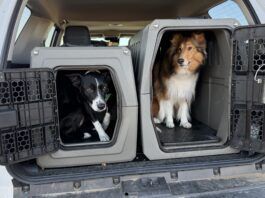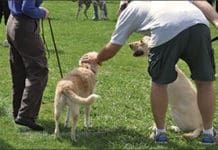Dog Certifications and Titles
My friend has super fast dogs, and they compete in agility. I always imagined that the magnets on the back of her vehicle indicated just how fast they could run: MACH speeds! And C-ATCH: Catch me if you can! Obviously my Border Collie, Duncan, and I didn't get far enough in our brief agility career to earn any titles (he preferred to make up his own courses). But when my curiosity got the better of me and I looked into what, exactly, those letters on my friend's car actually meant, I quickly learned that there are countless titles and certifications that can be bestowed upon our canine companions.
How Dogs Interpret Your Body Language
People who work successfully with dogs either have good instincts about how to interact with them, or they learn quickly. There is a real art to using body language to help a dog feel at ease with your presence. The most competent professionals make training look almost effortless, because all the messages they convey to their canine pupils are calm, clear, and consistent and that means both the cues and rewards they use consciously, and the posture and movements they use without thinking.
Advantages to Daily Training
There’s a good chance you’ve heard the phrase, “Any time you are with your dog you are training.” It’s commonly spoken by dog trainers as a way of reminding clients that their dogs are constantly being reinforced for behaviors – by the owner, by others, and by the environment. Behaviors that are reinforced increase in frequency, durability and strength. It behooves you to pay attention to what’s happening in your dog’s world so you can make sure he doesn’t have the opportunity to be reinforced for behaviors you don’t want, and even more importantly, so you can make sure you reinforce behaviors that you like.
Types of Dog Adoption Organizations
Types of Dog Adoption Organizations and How Each Can Go All Wrong
A Field Guide to Ethical Breeders
look for puppies from accomplished parents.üBuy a puppy from someone who brings her up in such a way that you wish every puppy could be raised that way. Australian Cattle Dog puppies bred by Ingrid Rosenquist.üWe tried to simulate the classic puppymill puppy portrait - the kind with cute props and a pup that looks like it's never been handled before and is stunned by the process. But we couldn't get this shelter puppy to look that shellshocked!üA home visit to see the puppies (or to meet the parents before the puppies are born) is a must. Puppies should be living in a house
Dog Rehoming: When Is It the Right Decision?
the harder she will be to rehome. Dogs who are very old
Tips for Adopting an Adult Dog
For a dog with such a demure name, Nora was, in the words of her new owner, purely awful. “There was not a thing that she got to that she did not destroy,” remembers Donna Hess of Basking Ridge, New Jersey, of the first few weeks with her newly adopted Basenji. “She ripped any pillow she could get to shreds, and then started on the comforters and blankets. She knocked over the garbage can 50 times a day. She chewed the other dogs’ collars off their necks. Tissues, toilet paper, knickknacks, throw rugs, small objects of all kinds were stolen or destroyed. Putting stuff up high did not help; she climbed all over the tables and counters. She literally could not be left alone for a second. And the worst thing was if you tried to catch her to confine her, she bit!”
Artificial Needs: Service-Dog Imposters Abound
An immaculately groomed Australian Shepherd sitting at his owner’s feet in an airplane’s bulkhead row. A yappy Malti-Poo in a shopping-cart seat at Target. A furiously wagging Lab-mix in line at the bank. If all three of these fictional Fidos were wearing vests that read “Service Dog,” you wouldn’t give them a second thought. Or would you?
How to be a “Dog Person”
If you are involved in dogs outside the four walls of your home – competing in performance events like agility or obedience, helping out with a rescue group, going to your local dog park – then, inescapably, you are involved with dog people. And no matter what the context, or how altruistic the goal, any time more than two people gather in the name of something they are passionate about, there are politics – and drama, mama.
Dog Games To Play if You Are Physically Impaired
How to exercise yourself at the same time you exercise your dog was the subject of Fitness Together" in the April 2013 issue of WDJ. But there are many reasons the human half of the equation may not be up for much physical exercise
Fitness Together
I confess: I have a hard time fitting in enough exercise for myself and my dog. Nothing earth-shattering about this admission; I think not getting enough exercise is a universal condition. Even though my dog and I walk daily, life and age just keep creeping up, making it harder and harder for me to stay fit. And, my high-energy herding dog seems to always need just a little more in the way of activity than I have time and energy to provide.
Beware of Dangerous Dog Laws
Anyone who has ever been bitten (or owned a dog who has been bitten) by a dog, or owned a dog who bit someone (human or canine) – or even just had a good look into a dog’s mouth! – understands that dogs have the potential to harm others. The vast majority of dogs are not dangerous. But, because of the minority who are, there are hundreds of laws, varying state by state and community by community, that attempt to define what dangerous dogs are, and address the consequences of a “dangerous dog” designation to the dogs’ owners and the dogs themselves.















